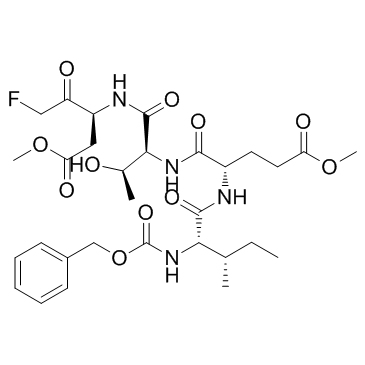| Cas No.: | 210344-98-2 |
| SMILES: | O=C(C(NC(=O)OCC1C=CC=CC=1)C(CC)C)NC(C(=O)NC(C(=O)NC(CC(=O)OC)C(=O)CF)C(C)O)CCC(=O)OC |
| Formula: | C30H43FN4O11 |
| M.Wt: | 654.68 |
| Purity: | >98% |
| Sotrage: | 2 years -20°C Powder, 2 weeks 4°C in DMSO, 6 months -80°C in DMSO |
| Description: | Z-IETD-FMK is a selective and cell permeable caspase 8 inhibitor. |
| Target: | Caspase-8 |
| In Vivo: | Pharmacological inhibition of caspase-8 by z-IETD-FMK robustly reduces tumour outgrowth and this is closely associated with a reduction in the release of pro-inflammatory cytokines, IL-6, TNF-α, IL-18, IL-1α, IL-33, but not IL-1β. Furthermore, inhibition of caspase-8 reduces the recruitment of innate suppressive cells, such as myeloid-derived suppressor cells, but not of regulatory T cells to lungs of tumour-bearing mice[4]. |
| In Vitro: | Z-IETD-FMK causes full inhibition only of the proapoptotic effect of TNFα with an IC50 of 0.46 μM[1]. Z-IETD-FMK and Z-VAD-FMK at non-toxic doses are found to be immunosuppressive and inhibit human T cell proliferation induced by mitogens and IL-2. They are shown to block NF-κB in activated primary T cells, but have little inhibitory effect on the secretion of IL-2 and IFN-γ during T cell activation[2]. Z-IETD-FMK inhibits the cleavage of caspase-8 and only partially inhibits the cleavage of caspase-3 and PARP. Z-IETD-FMK can prevent the execution of apoptosis in retinal cells exposed to different apoptotic stimuli[3]. |
| Cell Assay: | T cell proliferation following mitogen stimulation is determined using [3H]-thymidine incorporation. In brief, PBMCs or purified T cells are seeded at 1×106 cells/mL in 96 well plates and stimulated with either PHA (5 μg/mL or co-stimulated with anti-CD3 mAb (5 μg/mL) and anti-CD28 mAb (2.5 μg/mL) in the presence or absence of caspase inhibitor Z-IETD-FMK. The cells are cultured for 72 h with the last 16 h pulsed with [[3H]-labelled methyl-thymidine (0.037 MBq) prior to harvest onto glass fibre filter mats using a Tomtec automated multi-well harvester[2]. |
| Animal Administration: | Mice: Mice are divided into three groups: (1) naive, non-treated, mice; (2) CTR (control), i.t. instilled with NMU; and (3) lung cancer-bearing mice treated with Z-IETD-FMK (0.5 μg per mouse). The involvement of caspase-8 in lung cancer development is the determined at different time points (3, 7 and 28 days)[4]. |
| References: | [1]. Cowburn AS, et al. z-VAD-fmk augmentation of TNF alpha-stimulated neutrophil apoptosis is compound specific and does not involve the generation of reactive oxygen species. [2]. Lawrence CP, et al. Suppression of human T cell proliferation by the caspase inhibitors, z-VAD-FMK and z-IETD-FMK is independent of their caspase inhibition properties. Toxicol Appl Pharmacol. 2012 Nov 15;265(1):103-12. [3]. Tezel G, et al. Inhibition of caspase activity in retinal cell apoptosis induced by various stimuli in vitro. Invest Ophthalmol Vis Sci. 1999 Oct;40(11):2660-7. [4]. Terlizzi M, et al. Pharmacological inhibition of caspase-8 limits lung tumour outgrowth. Br J Pharmacol. 2015 Aug;172(15):3917-28. |

 To enhance service speed and avoid tariff delays, we've opened a US warehouse. All US orders ship directly from our US facility.
To enhance service speed and avoid tariff delays, we've opened a US warehouse. All US orders ship directly from our US facility.




















